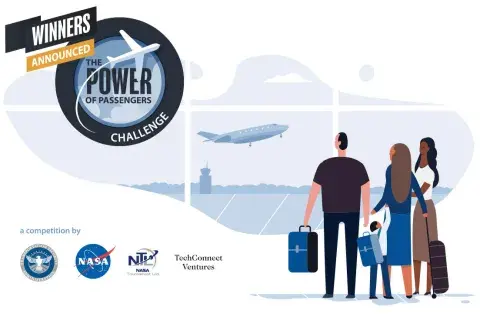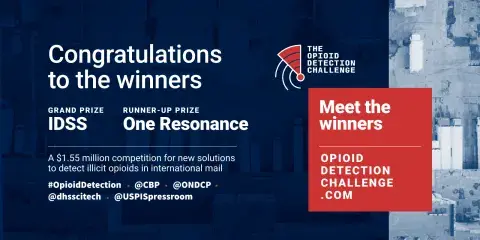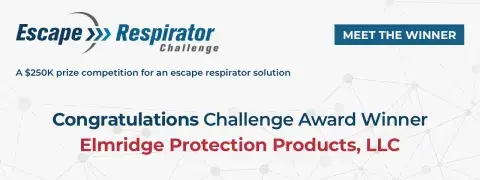Through prize competitions DHS has sought the inspiration of citizens to find creative solutions to tough problems that require a variety of perspectives.

And the grand-prize winner of the Digital Wallets Challenge is...
Dignari, a woman-owned small business from Alexandria, Virginia! Dignari received an additional $10,000 for the team’s winning design.
Congratulations to all who entered the Challenge, and to the three finalists:
- Dignari, LLC - Alexandria, Virginia
- Indicio, Inc. - Washington, DC
- Trinsic, Inc. - Provo, Utah
The $25,000 challenge, launched in September 2020, sought a design concept for an easy-to-use, trusted UI for digital wallets that improves the overall user experience (UX) for the management of digital wallet-based credentials. The challenge took place in two parts. In the first stage, contestants were judged on the design’s UI and end-to-end UX.
Three finalists were announced at a virtual community engagement event hosted by S&T on Tuesday, October 27, 2020. At the event, finalists presented their designs and received feedback from the standards and technical communities to prepare for stage 2 of the Challenge. Federal government experts and the World Wide Web Consortium (W3C), a standards group, provided insights and examples about how they are using, and developing, standards for digital wallets. Each finalist received $5,000 and advanced to the next stage of the challenge. The judges from USCIS, the State Department, and S&T chose one winning. However, all finalists did compelling work on implementing digital wallets and engaging with the standards and digital wallets technology community to incorporate feedback into their designs. The finalists submitted details of their work and explanation of how the teams combined an effective end-user experience and shareable back-end functionality for the verifiable credential community.
S&T has posted the winning UI for the global community to use and is talking to the standards, user, and technology developer communities on authentication and block chain technology. The UI artifacts can be found on GitHub under the SVIP Org.

In December 2020, TSA called on innovators and citizen inventors to leverage innovative approaches that would increase TSA’s security effectiveness and efficiency efforts and improve the passenger experience. To accomplish this mission, TSA asked for this in The Power of Passengers Challenge. The total prize purse was $215,000 split among one grand prize winner and ten focus area winners. The winners were:
Grand Prize Winner:
- Synthetik Applied Technologies, LLC, Texas $30,000
Most Creative Response
- Identy, Inc., Delaware, $5,000
Security Effectiveness
- First place: Wheel The World, California, $25,000
- Second place: ITsimple, LC, Georgia, $20,000
- Third place: Complex Systems, Texas, $15,000
More Efficient Options for Screening Passengers
- First place: SecureInsights, LLC and Point FWD, Washington, D.C., $25,000
- Second place: Larry Zeng and Megan Zeng, Utah, $20,000
- Third place: Daniel Saab, Ohio, $15,000
Improved Passenger Experience
- First place: HearRo, Inc., California, $25,000
- Second place: Knightscope, Inc., California, $20,000
- Third place: 101 Research LLC, Virginia, $15,000
The challenge invited innovators and citizen investors to submit responses with approaches or innovations that can re-envision how TSA generates, interprets, and uses data to improve security, efficiency, and passenger experience in one or more of the following areas of interest:
- Area of Interest 1: Security Effectiveness – Improved security outcomes, improved false alarm rate, increased detection of prohibited items, improved identification of mal-actors, better situational awareness of security performance and effectiveness, etc.
- Area of Interest 2: More Efficient Options for Screening Passengers – More efficient use of screening personnel, decreased number of procedural steps, decreased cost per passenger screened, increased passenger screening speed, increased number of passengers screened, improved use of airport infrastructure (physical constraints), etc.
- Area of Interest 3: Improved Passenger Experience – Decreased passenger queue wait times, improved passenger divestiture of items, increased predictability of experience, improved ease of experience, greater levels and options for autonomy and self-service, etc.

Illicit opioids such as fentanyl have created an unprecedented public health crisis across the United States. In 2017, approximately 50,000 Americans died from opioid overdoses. International mail — through both USPS and express consignment — has been identified as a route for illicit opioids entering the U.S., commonly transported in nearly pure, powdered form. Consequently, large-scale drug trafficking can occur via very small packages sent in the mail.
In February 2019, the U.S. Department of Homeland Security (DHS) Science and Technology Directorate (S&T), the White House Office of National Drug Control Policy (ONDCP), U.S. Customs and Border Protection (CBP), and the U.S. Postal Inspection Service (USPIS) launched a $1.55M multi-stage prize competition for rapid, non-intrusive detection tools that would help find illicit opioids in international mail.
In Stage 1, the Challenge called for well-developed plans for automated, user-friendly tools and technologies that had the potential to quickly and accurately detect opioids in parcels, without disrupting the flow of mail. The Challenge received 83 submissions from U.S. and international innovators. From those submissions eight finalists were chosen, each received $100,000 in cash prizes and advanced to Stage 2 of the competition. In Stage 2, finalists participated in a 14-week prototyping accelerator, where they developed their plans into testable prototypes, culminating in a live test event, where finalists convened at the DHS Transportation Security Laboratory in Atlantic City, New Jersey for on-site testing of their prototypes and competed for an additional $750,000 in cash prizes.
On December 12, 2019, DHS S&T announced the grand prize winner and runner-up in the Opioid Detection Challenge. IDSS received the grand prize of $500,000 for its detection solution, which combines a 3D X-ray computed tomography (CT) scanner with automated detection algorithms. The runner-up, One Resonance, received $250,000 for its detection solution, the QROD system, which is a quadrupole resonance technology that uses radio-frequency signals to search for specific materials.
S&T and its government partners plan to continue working with the providers of the most promising solutions to further develop prototypes and establish follow-on production agreements. The government plans to deploy these tools in international mail facilities, express consignment facilities, and other environments across the country that call for rapid, accurate detection of opioids and related substances.

In December 2018, the DHS Science and Technology Directorate launched the $250,000 Escape Respirator Challenge. The challenge invited the innovation community to develop a compact, discreetly-carried escape respirator that can be used quickly for safe egress from smoke-filled, oxygen-deficient, and chemical, biological, and radiological (CBR) environments. Although commercial solutions for escape hoods or respirators exist, most currently-available models lack an oxygen delivery mechanism for respiratory protection when worn in an oxygen-deficient environment, such as a smoke-filled room. They also do not have the small form factor, in packaging or weight reduction, sought through the Challenge.
The first stage of the competition called upon the innovation community to submit relevant, useable, effective and feasible concepts for an escape respirator that provides oxygen and protects the user against aerosolized CBR hazards. From the initial submissions, three finalists were selected and each received $50,000 to expand their concepts and develop prototypes for demonstration in front of an interagency panel of judges.
In January 2020, the judges determined Elmridge Protection Products, LLC as the $100,000 grand prize winner for their iEvac E700 Mini-ReBreather concept. The concept involves delivery of a controlled flow of oxygen from a generator to a sealed hood with an oral-nasal mask and integrated carbon dioxide scrubber.
For information on historical prize challenges follow the below links:
